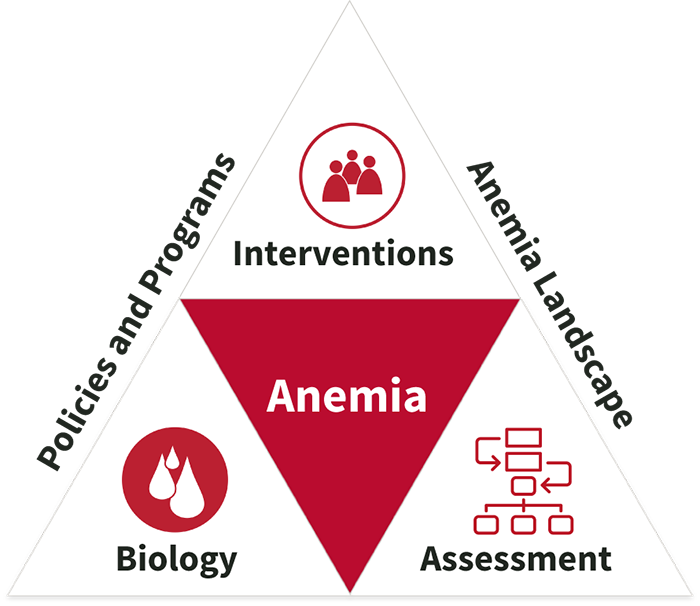Anemia is a public health concern disproportionately affecting young children, pregnant women, and women of reproductive age. The Global Burden of Disease Study estimates that iron deficiency anemia and thalassemia are the leading anemia causes worldwide.
While anemia is prevalent around the world, the underlying causes differ among different populations and regions. A “one size fits all” approach does not exist, and implementation of strategies to reduce anemia depend on the main causes of anemia, and the financial and technical capacity of each country.
We found 93 resource(s)
Ferric Carboxymaltose Versus Standard-of-Care Oral Iron to Treat Second-Trimester Anaemia in Malawian Pregnant Women: A Randomised Controlled Trial
Journal Article published by Lancet in
This paper presents the results of an open-label, individually randomized controlled trial of a single dose of a modern intravenous iron formulation, ferric carboxymaltose, for anaemia treatment in pregnant women in Malawi with a singleton pregnancy of 13–26 weeks' gestation in primary care and outpatient settings.
Effects of Iron Supplementation on Neural Indices of Habituation in Bangladeshi Children
Journal Article published by Am J Clin Nutr in
This paper reports on the effect of iron supplementation on neural indices of habituation using auditory event-related brain potentials within a three-arm, double-blind, double-dummy, individual randomized trial in Bangladesh, in which 3,300 eight-month-old children were randomly selected to receive three months of daily iron syrup (12.5 mg iron…
Supplementation With Iron Syrup or Iron-Containing Multiple Micronutrient Powders Alters Resting Brain Activity in Bangladeshi Children
Journal Article published by Journal of Nutrition in
This study reports on the results of supplementation with iron or multiple micronutrient powders (MNPs) on brain activity measures using resting electroencephalography within a three-arm, double-blind, double-dummy, individual randomized trial in Bangladesh, in which 3,300 eight-month-old children were randomly selected to receive three months of…
Advancing Nutrition: The Fight for Health of Children and Mothers in South Kyrgyzstan
Video/Animation published by USAID Kyrgyz Republic in
Four in ten children in remote areas of the Kyrgyz Republic are at risk for anemia and less than 20 percent of children ages 6–23 months consume a minimum acceptable diet. This video, which is available in English, Russian, and Kyrgyz, highlights USAID Advancing Nutrition’s work with families in very remote areas.
Iron, Folic Acid, and Multiple Micronutrient Supplementation Strategies during Pregnancy and Adverse Birth Outcomes in Botswana
Journal Article published by The Lancet Global Health in
Researchers tested four supplementation strategies and found that women who used multiple micronutrient supplementation had lower risk of preterm and very preterm births and low and very low birthweight when compared with other supplementation protocols.
A Cross-Sectional Study of the Associations between Biomarkers of Vitamin D, Iron Status, and Hemoglobin in South African Women of Reproductive Age: the Healthy Life Trajectories Initiative, South Africa
Journal Article published by Curr Dev Nutr in
This study aimed to assess the associations between serum vitamin D and biomarkers of iron and anemia in a cohort of women of reproductive age from Soweto, South Africa, within a cross-sectional substudy of the Healthy Life Trajectories Initiative South Africa pilot trial.
The Prevalence of Anemia in Children Aged 6–23 Months and Its Correlates Differ by District in Kapilvastu and Achham Districts in Nepal
Journal Article published by Curr Dev Nutr in
This study analyses the predictors of anemia in young Nepali children aged 6–23 months in two districts of Nepal: Kapilvastu and Achham.
Spatial Variation and Attributable Risk Factors of Anaemia Among Young Children in Uganda: Evidence from a Nationally Representative Survey
Journal Article published by PLOS Glob Public Health in
This study describes the spatial variation and attributable risk factors of anemia at the national level in Uganda among children aged 6–59 months, using data from the 2016 Uganda Demographic and Health Survey.



